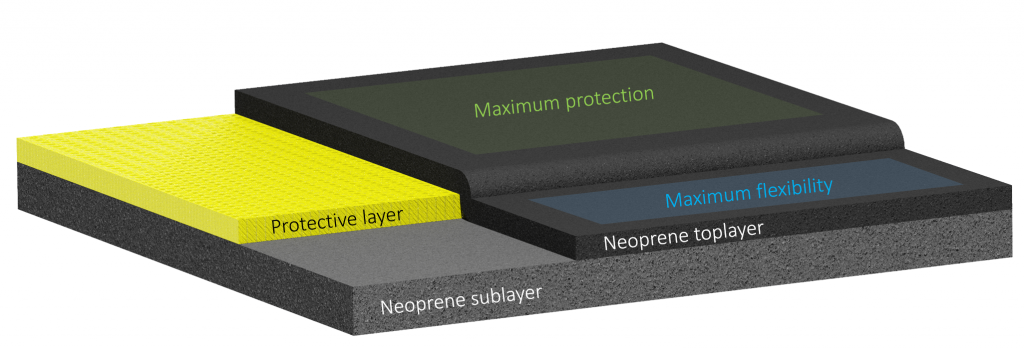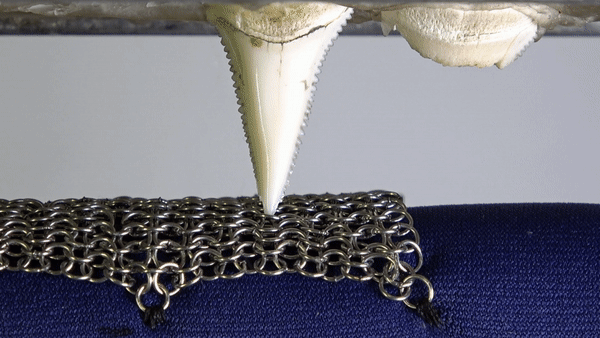Shark attacks have been on the rise in Australia – but a high-strength material could give surfers more confidence in the water.
Sharks loom large in the Australian imagination. Perhaps for good reason: the country has the largest number of reported fatal shark attacks anywhere in the world – a number which has increased over the past few decades.
Materials scientist Dr Thomas Fiedler told create that despite the rise, fatal incidents are still a relatively low occurrence, currently averaging 2.5 per year in Australia – versus 1200 road fatalities and 200 drownings.
“Putting it into perspective, when you’re driving by car to the beach, that’s a lot more dangerous,” he said.
Nonetheless, it’s an unnerving prospect for surfers and swimmers, and something Fiedler is trying to address as CEO and co-founder of Newcastle-based start-up Aqua Armour, which has developed a prototype ‘shark-resistant’ wetsuit.
Fiedler, a materials scientist and associate professor at the University of Newcastle, has close to two decades of experience researching advanced composite materials.
In 2015, he was approached by colleague, professor Chris Dayas who runs the anatomy lab at University of Newcastle.
A keen surfer, Dayas wanted to know if high-strength materials could protect against shark bites. The pair combined forces with University of Newcastle graduate students Trent Verstegen and Alex Vardanega to found Aqua Armour.
In the years since, they’ve assembled a multidisciplinary team – with expertise in human anatomy, kinesiology, material science and engineering, and shark behaviour – and made significant progress on their prototype, which features a novel fibre-reinforced composite in a traditional neoprene wetsuit.
Fiedler said, while a wetsuit couldn’t entirely reduce the impact of a shark bite, the goal is to significantly enhance “survivability”.
“It’s a bit like a seatbelt in the car. Your seatbelt doesn’t guarantee saving your life – but it really stacks the odds in your favour.”
Borrowing from chainmail and bullet-proof vests
Though they’re excellent at buffering against the cold, traditional wetsuits don’t stand a chance against the bite force of a shark, which is estimated to be able to reach almost 4700 N in great whites.
Existing shark-resistant technology like ‘sharksuits’ are made with chainmail, but these are typically heavy, designed only for diving, and prohibitively expensive to the casual user.
“It’s very easy to create a material that can withstand a shark bite – you could put a bit of steel plate in there, and you’d be fine,” said Trent Verstegen who worked on the project while studying mechanical and mechatronics engineering at the University of Newcastle.
Now part of the Aqua Armour team, Verstegen said, considering the complex motions of surfing, the major challenge has been discovering a material that will not only resist a bite but is also flexible and comfortable to wear.
“Trying to find that material and work that into the geometries of the wetsuit in places that aren’t going to strain or be overstressed or uncomfortable was definitely the biggest challenge,” he said.
Leveraging Dayas’s anatomy expertise, the team decided to focus on protecting the areas of the human body that are most likely to prove fatal if bitten – such as the major arteries in your legs and upper arms.
As Verstegen puts it: “We reinforce the areas where, if you get punctured there, it’s hours, not minutes that you’ve got left.”
Fiedler said this “very localised reinforcement” helps optimise weight, mobility, and cost of the suits.
A key material they’re working with is a novel fibre-reinforced composite featuring Kevlar fibres – a material used in bulletproof vests – within an elastic matrix. Protective pads of the material are “sandwiched” into a neoprene suit.

Fiedler said they’ve also “gone back to medieval times” and been inspired by chainmail, which they are investigating as another option.
“If you have the right ring geometry and the right joining technology, you end up with something akin to a high-tech chainmail,” he explained.
Lab testing and motion capture
So far testing has remained in the lab rather than the ocean. The team tried testing with actual shark teeth but switched to a standardised rig featuring hardened steel knives, which are stronger than actual teeth.
Fiedler said instead of human tissue they used “a clay that does an excellent job of replicating it”.
“We started off by trying to use some prime meat cuts, the problem is they’re way too soft.”
They also used motion capture technology for strain analysis, testing standard surfing motions like paddling, popping up and standing.
“We mapped surfaces of the human body and checked for high strains,” Fiedler said.
“It doesn’t matter if it’s tension or compression, if there is a region that has high strains, we don’t want to reinforce it, because that gets in the way if you want to move.”
Even though “he can’t surf to save his life”, Verstegen has tested the latest prototype and says it’s as comfortable as a regular wetsuit.
Protecting life in marine environments
Ironically, Aqua Armour’s tech could protect more than just human life. Fiedler said if the wetsuits become widespread, they could reduce the need for harmful shark control measures.
“By offering personal protection, we hope that governments can move away from shark nets and culling, and we can actually save marine environments.”
One day, consumers might even have several choices of shark-proof wetsuits. Another New South Wales-based start-up, Shark Stop, is working with Flinders University researchers on different protective technology.
Verstegen adds that Aqua Armour’s high-strength material could have applications outside the water – such as abrasion resistance in sports like downhill mountain biking.
Fiedler said the ultimate goal remains saving human lives: “My biggest dream is one day to shake the hand of someone who got attacked by a shark while wearing our wetsuit – and made it.”
Engineers looking to connect with like-minded engineers on specific areas of technical practice, such as materials, can visit Engineers Australia’s Technical Societies page.
